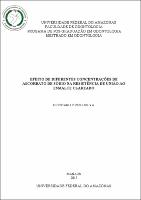| ???jsp.display-item.social.title??? |


|
Please use this identifier to cite or link to this item:
https://tede.ufam.edu.br/handle/tede/4292| ???metadata.dc.type???: | Dissertação |
| Title: | Efeito de diferentes concentrações de ascorbato de sódio na resistência de união ao esmalte clareado |
| ???metadata.dc.creator???: | Silva, Cristiano Pires e  |
| ???metadata.dc.contributor.advisor1???: | Martins, Leandro de Moura |
| ???metadata.dc.description.resumo???: | Após finalizar o tratamento de clareamento dentário os subprodutos da reação permanecem na estrutura dentária impedindo a correta polimerização das restaurações adesivas. O objetivo deste trabalho foi investigar os efeitos antioxidantes do hidrogel de ascorbato de sódio sobre o oxigênio residual na estrutura de esmalte bovino clareado com peróxido de hidrogênio e posteriormente restaurado com resina composta. Cento e vinte dentes bovinos foram divididos em 12 grupos (n=10), os grupos G1;G2;G3;G4;G5;G6 foram submetidos ao teste de cisalhamento após uma semana, os grupos G7;G8;G9;G10;G11;G12 foram testados após seis meses (envelhecimento), sendo G1;G7 - restaurado sem clareamento; G2;G8 - clareado e restaurado após 14 dias; G3;G9 - clareado e restaurado no mesmo dia; G4;G10 - clareado, tratado com hidrogel de ascorbato de sódio 10% e restaurado; G5;G11 - clareado, tratado com hidrogel de ascorbato de sódio a 20% e restaurado e G6;G12 - clareado, tratado com hidrogel de ascorbato de sódio a 40% e restaurado. Os resultados do teste de cisalhamento foram submetidos a ANOVA a 2 critérios e teste de Tukey para comparação das medias (p≤ 0,05). Os grupos G1: 152,6N +-‐ 21,2; G2: 183,2N +-‐ 31,4; G5: 171,53N +-‐ 20,6; G6: 179,9N +-‐ 33,1 apresentaram resistência ao cisalhamento semelhante e os grupos G3: 99,3N +-‐ 33,9; G4: 101,3N +-‐ 29,3 apresentaram resistência inferior estatisticamente significativa. O segundo grupo apresentou menor resistência ao cisalhamento porém, mantive o mesmo padrão de diferença estatística entre os grupos. Os grupos envelhecidos G7: 98,1N +- 22,6; G8: 111,9N +- 34,0; G11: 91,9N +- 24,0; G12: 90,0N +- 13,1 apresentaram menor resistência ao cisalhamento quando comparados aos não envelhecidos. No entanto, quando comparado entre os envelhecidos, assim como nos não envelhecidos, os grupos G9: 59,3N +- 19,9; G10: 59,7N +- 10,9 também apresentaram resistência inferior comparado aos demais grupos. Podemos concluir que o clareamento dental com o peróxido de hidrogênio a 35% promoveu redução da resistência adesiva. Além disso, o tratamento do esmalte clareado com hidrogel de ascorbato de sódio a 20% e a 40% permitiu alcançar valores de resistência de união similar ao esmalte não clareado. |
| Abstract: | After completing the tooth bleaching, reaction products remain in the tooth structure not allowing the correct polymerization of adesives restorations. The purpose of this study was to investigate the antioxidants effects of sodium ascorbate hydrogel on the residual oxygen in the bovine enamel structure bleached with hydrogen peroxide and after restorated with composite resin. One hundred and twenty bovines teeth were divided into twelve groups (n: 10), the groups G1;G2;G3;G4;G5;G6 were subjected to a test of shear strength after one week, the groups G7;G8;G9;G10;G11;G12 were tested after six months (aged), being G1; G7 - restored without bleaching ; G2; G8 - bleached and restored after fourteen days; G3; G9 - bleached and restored at the same day; G4; G10 - bleached, treated with sodium ascorbate hydrogel of 10% and restored; G5; G11 - bleached, treated with sodium ascorbate hydrogel of 20% and restored and G6; G12 - bleached, treated with sodium ascorbate hydrogel of 40% and restored. The results of the shear test were subjected to two ANOVA’s criteria and Tukey's analysis to compare the scores (p≤ 0,05). The groups G1: 152,6N +- 21,2; G2: 183,2N +- 31,4; G5: 171,53N +- 20,6; G6: 179,9N +- 33,1 showed similar resistance to shear and the groups G3: 99,3N +- 33,9; G4: 101,3N +- 29,3 were statistically significant lower resistance. The second group had lower shear resistance, however maintained the same pattern of statistical difference between the groups. The aged groups G7: 98,1 +- 22,6; G8: 111,9 +- 34,0; G11: 91,9 +- 24,0; G12: 90,0 +- 13,1 showed lower shear resistance when compared to the non-aged. However, when compared between the aged, as well as between no-aged, the groups G9: 59,3 +- 19,9; G10: 59,7 +- 10,9 also showed lower resistance when compared to the others groups. We can conclude that the tooth bleaching with 35% hydrogen peroxide promoted reduction of the bond strength. In addition, treatment of the bleached enamel with 20% and 40% sodium ascorbate hydrogel allowed to reach values of bond strength similar of the enamel not bleached. |
| Keywords: | Clareamento dental Antioxidante Resistência ao Cisalhamento Tooth whitening Antioxidant Shear Strength |
| ???metadata.dc.subject.cnpq???: | CIÊNCIAS DA SAÚDE: ODONTOLOGIA |
| Language: | por |
| ???metadata.dc.publisher.country???: | Brasil |
| Publisher: | Universidade Federal do Amazonas |
| ???metadata.dc.publisher.initials???: | UFAM |
| ???metadata.dc.publisher.department???: | Faculdade de Odontologia |
| ???metadata.dc.publisher.program???: | Programa de Pós-graduação em Odontologia |
| Citation: | SILVA, Cristiano Pires e. Efeito de diferentes concentrações de ascorbato de sódio na resistência de união ao esmalte clareado. 2015. 50 f. Dissertação (Mestrado em Odontologia) - Universidade Federal do Amazonas, Manaus, 2015. |
| ???metadata.dc.rights???: | Acesso Aberto |
| URI: | http://tede.ufam.edu.br/handle/tede/4292 |
| Issue Date: | 6-Feb-2015 |
| Appears in Collections: | Mestrado em Odontologia |
Files in This Item:
| File | Description | Size | Format | |
|---|---|---|---|---|
| Dissertação-Cristiano P e Silva.pdf | 2.7 MB | Adobe PDF |  Download/Open Preview |
Items in DSpace are protected by copyright, with all rights reserved, unless otherwise indicated.




